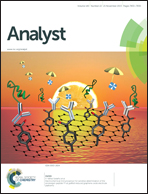An integrated metabolomics workflow for the quantification of sulfur pathway intermediates employing thiol protection with N-ethyl maleimide and hydrophilic interaction liquid chromatography tandem mass spectrometry†
Abstract
The sulfur metabolic pathway is involved in basic modes of cellular metabolism, including methylation, cell division, respiratory oscillations and stress responses. Hence, the implicated high reactivity of the sulfur pathway intermediates entails challenges for their quantitative analysis. In particular the unwanted oxidation of the thiol group-containing metabolites glutathione, cysteine, homocysteine, γ-glutamyl cysteine and cysteinyl glycine must be prevented in order to obtain accurate snapshots of this important part of cellular metabolism. Suitable analytical methodologies are therefore needed to support studies of drug metabolism and metabolic engineering. In this work, a novel sample preparation strategy targeting thiolic metabolites was established by implementing thiol group protection with N-ethyl maleimide using a cold methanol metabolite extraction procedure. It was shown that N-ethyl maleimide derivatization is compatible with typical metabolite extraction procedures and also allowed for the stabilization of the instable thiolic metabolites in a fully 13C-labeled yeast cell extract. The stable isotope labeled metabolite analogs could be used for internal standardization to achieve metabolite quantification with high precision. Furthermore, a dedicated hydrophilic interaction liquid chromatography tandem mass spectrometry method for the separation of sulfur metabolic pathway intermediates using a sub-2 μm particle size stationary phase was developed. Coupled with tandem mass spectrometry, the presented methodology proved to be robust, and sensitive (absolute detection limits in the low femtomole range), and allowed for the quantification of cysteine, cysteinyl glycine, cystathionine, cystine, glutamic acid, glutamyl cysteine, reduced glutathione, glutathione disulfide, homocysteine, methionine, S-adenosyl homocysteine and serine in a human ovarian carcinoma cell model.


 Please wait while we load your content...
Please wait while we load your content...